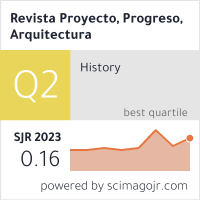REVISITING PUBLIC SPACE IN POST-WAR SOCIAL HOUSING IN GREAT BRITAIN / Repensando el espacio público de las viviendas sociales de post-guerra en Gran Bretaña
DOI:
https://doi.org/10.12795/ppa.2013.i9.07Palabras clave:
public space, slum clearance, neighbourhood, urban obsolescence, regeneration, London / espacio público, demolición de infravivienda, barriada, obsolescencia urbana, regeneración, LondresResumen
SUMMARY This paper addresses the issue of the urban obsolescence of public space of social housing neighbourhoods built during the post-war period in Great Britain. Great Britain has been chosen because of the active role played by modern architects in the construction of the welfare state advocated by post-war governments, which involved building large areas of social housing. The aims of this paper are to understand the context in which these neighbourhoods were built as well as their evolution and the complexity of their obsolescence. To achieve these objectives, it first looks at the causes that prompted the slum clearance process, at its implementation during the post-war reconstruction and at the effects that this process has had on contemporary cities. Secondly, it is illustrated through a detailed analysis of a case study, Loughborough Estate in Brixton, London, looking at the initial conditions of the council estate when it was built, investigating its evolution over the past five decades and factors that may have contributed to the obsolescence of its public space and to its social problems. The paper concludes with a warning that a generalist critique of modern architecture does not solve the problems of such neighbourhoods, but a substantial intervention on the public space is needed to bring them to life. These interventions should focus on the spatial configuration of public space and its design and maintenance.
RESUMEN Este artículo aborda la cuestión de la obsolescencia urbana del espacio público en las barriadas de viviendas sociales construidas durante el periodo de post-guerra en Gran Bretaña. Se ha escogido el caso de Gran Bretaña debido al papel tan activo que tuvieron los arquitectos del movimiento moderno en la construcción del estado del bienestar, por la que abogaron los gobiernos de post-guerra y la cual implicó la construcción de una gran cantidad de viviendas. Los objetivos de este artículo son comprender el contexto en el que se construyeron estas barriadas así como su evolución y la complejidad de su obsolescencia. Para alcanzar estos objetivos, primero se examinan las causas que dieron lugar al proceso de demolición de infraviviendas, su ejecución durante la reconstrucción de post-guerra y los efectos que este proceso ha tenido en las ciudades contemporáneas. En segundo lugar, esto se ilustra con un análisis detallado de un caso de estudio: Loughborough Estate en Brixton, Londres. Se examinan cuáles eran las condiciones iniciales de la barriada social y se investiga su evolución durante las cinco últimas décadas y los posibles factores que han contribuido a la obsolescencia del espacio público y a sus problemas sociales. El artículo concluye advirtiendo que una crítica generalista a la arquitectura moderna no resuelve los problemas de estas barriadas, sino que es necesaria una intervención sustancial en el espacio público para fomentar la vida urbana. Estas intervenciones deben actuar sobre la configuración espacial del espacio público y sobre su diseño y mantenimient
Descargas
Citas
Bullock, Nicholas: Building the post-war world: modern architecture and reconstruction in Britain. London: Routledge, 2002.
Carolin, Peter: “Sense, sensibility and tower blocks: the Swedish influence on post-war housing in Britain”. In Harwood, Elain; Powers, Alan (Ed.): Housing the twentieth century. London: Twentieth Century Society, 2008. pp. 98-112.
Coleman, Alice: Utopia on trial: vision and reality in planned housing. London: Hilary Shipman, 1985. Revised edition 1990.
Gehl, Jan: Life between buildings: using public space. Revised edition. Washington DC: Island Press, 2011.
Hanson, Julienne: “Urban transformations: a history of design ideas”. In Urban Design International. August 2000, Nº 5 (2).
Basingstoke (Hants, U.K.): Palgrave Macmillan. 2000, pp. 97-122. DOI: 10.1057/palgrave.udi.9000011.
Harwood, Elain: “The road to subtopia: 1940 to the present”. In Saint, Andrew (Ed.): London Suburbs. London: Merrell Holberton in association with English Heritage, 1999. pp. 130-162.
Hall, Peter: Cities of Tomorrow. Oxford: Blackwell Publishers, 1988. Reprinted in 1994.
Hillier, Bill and others: “Space Syntax. A different urban perspective”. In The Architect’s Journal. 30 November 1983, Nº 48 (178). London: Architectural Press, 1983. pp. 47-64.
Hillier, Bill: Space is the machine: a configurational theory of architecture [online]. Cambridge: Press Syndicate of the University of Cambridge, 1996. Electronic ed., with a new preface, 2007.
[Quoted on March 2, 2013]. Available at the World Wide Web: http://discovery.ucl.ac.uk/3881/1/SITM.pdf
Hillier, Bill; Vaughan, Laura: “The city as one thing”. In Progress in Planning. April 2007, Nº 67 (3). Oxford: Pergamon-Elsevier Science, 2007. pp. 205-230. DOI: 10.1016/j.progress.2007.03.001.
Lambeth: Angell Ward profiles 1979-1982. London: Lambeth, 1982. Source: Lambeth Archives.
London Borough of Lambeth. Planning Application database [online]. London: London Borough of Lambeth, n.d. [Quoted on August 5, 2013] Available at the World Wide Web: http://planning.lambeth.gov.uk/online-applications/
Minton, Anna: Ground control: fear and happiness in the twenty-first-century city. London: Penguin, 2009.
Mumford, Eric: The CIAM Discourse on Urbanism, 1928-1960. Cambridge, Massachusetts: The MIT Press, 2000. PMCid:PMC1723562.
Newman, Oscar: Defensible space: crime prevention through urban design. New York: Macmillan, 1972.
Office for National Statistics. National Neighbourhoods Statistics [online]. Newport (South Wales, U.K.): Office for National Statistics, 2011. [Quoted May 29, 2013]. Available at the World Wide Web: http://www.neighbourhood.statistics.gov.uk/
Partridge, John: “Roehampton Housing”. In Harwood, Elain; Powers, Alan (Ed.): Housing the twentieth century. London: Twentieth Century Society, 2008. pp. 114-120.
Pope, Albert: Ladders, Houston: Rice University School of Architecture, 1996.
Rogers, Richard; Power, Anne: Cities for a small country. London: Faber and Faber, 2000.
Scarman, Lord: The Brixton disorders 10-12 April 1981. London: Her Majesty’s Stationeary Office, 1981.
Sennett, Richard: “The public realm”. Paper presented at BMW Foundation Workshop on Changing Behaviour and Beliefs [online]. Lake Tegernsee (Germany), 2008. [Quoted on February 2, 2011] Available at the World Wide Web: http://www.richardsennett.com/site/SENN/Templates/General2.aspx?pageid=16
Smithson, Alison (Ed.): Team 10 meetings. New York: Rizzoli International Publications, 1991.
Young, Michael; Willmott, Peter: Family and Kinship in East London. First published in the U.S.A: 1957. Great Britain: Routledge and Kegan Paul, 1957. Revised edition Middlesex (U.K.): Penguin 1962, reprinted 1972.
Descargas
Publicado
Cómo citar
Número
Sección
Licencia
Las ediciones impresa y electrónica de esta Revista son editadas por el Secretariado de Publicaciones de la Universidad de Sevilla, siendo necesario citar la procedencia en cualquier reproducción parcial o total.
Salvo indicación contraria, todos los contenidos de la edición electrónica se distribuyen bajo una licencia de uso y distribución “Creative Commons Atribución-NoComercial-SinDerivar 4.0 Internacional” ![]() . Puede consultar desde aquí la versión informativa y el texto legal de la licencia. Esta circunstancia ha de hacerse constar expresamente de esta forma cuando sea necesario.
. Puede consultar desde aquí la versión informativa y el texto legal de la licencia. Esta circunstancia ha de hacerse constar expresamente de esta forma cuando sea necesario.
Los autores/as que publiquen en esta revista aceptan las siguientes condiciones:
- Los autores/as conservan los derechos de autor y ceden a la revista el derecho de la primera publicación, con el trabajo registrado con la licencia de atribución de Creative Commons, que permite a terceros utilizar lo publicado siempre que mencionen la autoría del trabajo y a la primera publicación en esta revista.
- Los autores/as pueden realizar otros acuerdos contractuales independientes y adicionales para la distribución no exclusiva de la versión del artículo publicado en esta revista (p. ej., incluirlo en un repositorio institucional o publicarlo en un libro) siempre que indiquen claramente que el trabajo se publicó por primera vez en esta revista.
- Se permite y recomienda a los autores/as a publicar su trabajo en Internet (por ejemplo en páginas institucionales o personales) antes y durante el proceso de revisión y publicación, ya que puede conducir a intercambios productivos y a una mayor y más rápida difusión del trabajo publicado (vea The Effect of Open Access).









